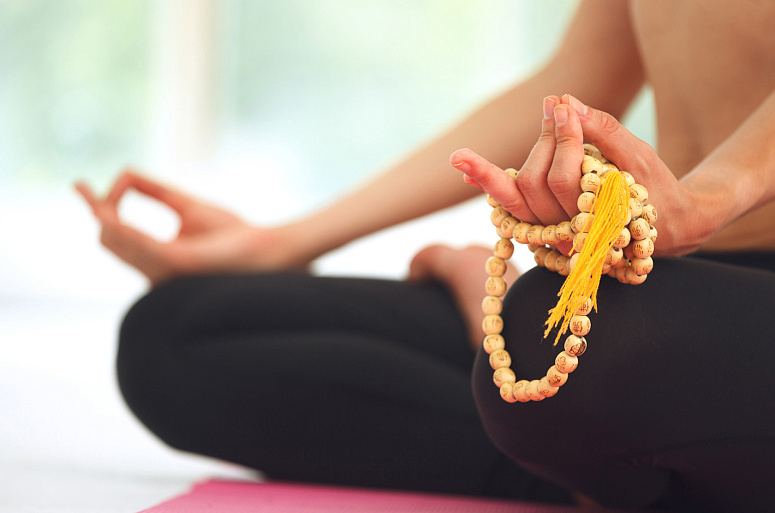“The mantra “so” naturally deepens inhalation and improves the quality of prana, or life energy; the mantra “hum,” accordingly, deepens exhalation and expels excess apana, or descending air. This pranayama is beneficial for any constitution” (“Healing Mantras in Ayurveda,” S.M. Neapolitansky).
The word “mantra” is composed of two parts: “man” - ‘to think’ (reminiscent of “manas” - ‘mind’) and “tra” - ‘instrument.’ Therefore, “mantra” literally translates to ‘instrument of thought,’ one of the strongest and most accessible methods of spiritual practice. Mantras are present in many religions and pathways of self-development - buddhism, hinduism, taoism, sufism, sikhism - and japanese and chinese spiritual martial arts also involve instruments similar to mantras. They are also used in yoga and Ayurveda. In this article, we will discuss the most simple and, if such an expression is suitable, physiological mantra So-Hum.
So-Hum — a mantra used in Ayurveda
A mantra is a set of sounds, words, or word combinations that has a spiritual, psychological, and resonant effect. Resonance activates zones of the body, which is why mantras affect individuals’ wellbeing and health.
One of the simplest but highly effective mantras is So-Hum, pronounced like the English words “so” and “hum.” This is a most natural method of observing one’s breathing: “so” is pronounced during the inhale, “hum” during the exhale. This mantra is used separately from consciousness, i.e. it can end only with the termination of breathing, and is therefore simple and accessible to all.
The practice of So-Hum simultaneously combines elements of mantra, meditation, and pranayama. According to Ayurveda, this mantra harmonizes all three doshas and increases life energy (ojas).
This mantra is sometimes pronounced differently, as “Om So-Hum.”
- “Om”— the sound that manifested at the origin of the Universe, a word that frequently precedes many mantras and activates cosmic energies;
- “So” — the pronoun ‘he/that,’ which refers to the flow of energy, the God Shiva, the Universe;
- “Hum” — the affirmation that ‘I am,’ ‘I exist.’
The most prevalent translation of So-Hum is ‘I am that' (the endless flow of life). Breathing during this exercise maintains the spiritual essence of a person and prevents him from leaving until his inner purpose is fulfilled.
Here is a piece of Swami Satyananda Saraswati’s commentary on this practice, found in his novel “A Systematic Course in the Ancient Techniques of Yoga and Kriya”: “However, the reader should not worry too much about the meaning, unless he or she has had a deep transcendental experience. Any attempt to understand the meaning of So-Hum logically will lead to delusion. It can only be understood at an intuitive level. when a person understands its transcendental meaning, and only then, can it be used as a means of constant affirmation and remembrance.”
“Sa-Hum” and “So-Hoom” (with an “oo” sound as in “too”) are also variants of this mantra.
Interestingly, the mantra So-Hum sounds like “Hum-So” when recited backwards, which translates as ‘white swan’ - the personification of a person’s soul, his inner self.
According to legend, Shakti heard “So-Hum” during Shiva’s meditation and exclaimed, “Beloved, I hear you! And you sound so beautiful!” Shakti repeated these melodies and delivered them to the world.
So-Hum breathing technique
Ideally, practice should be preceded by preparation:
- wash your face, hands, and feet;
- let go of unpleasant experiences and get into a positive mindset;
- create suitable conditions: ventilate the room, find a quiet, secluded place where no person or thing can distract you.
But don’t feel disappointed or postpone practice if you lack the time for preparation; begin reciting So-Hum right away.
Time and duration. Performing this practice after awakening and/or before sleep for at least 10-20 minutes is beneficial; but if you have less time or, on the contrary, a spare period in the middle of the day, don’t hesitate to start practicing.
The most favorable positions for reciting So-Hum are considered to be Siddhasana, Padmasana, and Vajrasana. In the case of contraindications to any of these asanas, you can practice in any other pose with a straight spine or, in difficult cases, Shavasana (lying on one’s back).
Instruction. The technique of So-Hum breathing is quite simple. Having taken the position, at first it’s important to simply concentrate on breathing and observe it.
Then, non-verbally pronounce “so” on the inhale and “hum” on the exhale. At first, you can pronounce the mantra in a barely audible whisper, but it’s important to eventually transition to a silent recital. Always inhaling and exhaling through your nose, concentrate on your breathing and continue to chant So-Hum in sync. If something distracts the mind, you must softly redirect it back to the breath.
For experienced practitioners it is possible to recite So-Hum while concentrating on the movement of energy within the body.
The consciousness must follow the energy’s flow.
- When inhaling, this movement occurs along the so-called frontal psychic pathway or front plane of the body, which is called Arohan in Ayurveda. Consciousness rises from Muladhara, located in the perineum, and subsequently through all chakras up to Bindu at the back of the head.
- When exhaling, the energy accompanied by “hum” flows along the Avarohan channel, or along the spine, passing through the chakras in reverse order. Completing the cycle, the energy temporarily remains at Muladhara as the sound “m” reverberates.
- There is no need to pronounce the names of the chakras as the consciousness travels; everything must occur on the level of sensations or feelings.
To conclude the practice, you should spend 2-3 minutes in silence with your eyes closed.
Even reflecting on this mantra can help awaken wisdom, for So-Hum is a mantra that truly frees the soul.
Benefits and results of the So-Hum technique:
- simple and accessible to all, regardless of age or level of training;
- positively increases efficiency, even during multitasking;
- improves memory and concentration;
- calms the mind;
- awakens creative abilities;
- eliminates anxiety and depressive tendencies.
We’ll conclude with an excerpt from Vasant Lad’s “The Complete Book of Ayurvedic Home Remedies”: “Hum means ‘I,’ or ‘individual ego.’ So means ‘He, the Divine.’ So in the natural course of So-Hum meditation, when So goes in, life energy goes in and Hum, ego, our limited individuality, goes out. That is the significance of So-Hum meditation. When you inhale So, you are inhaling life. When you exhale Hum, you are exhaling ego and limitation.
So-Hum meditation properly performed leads to the union of the individual with the universal Cosmic Consciousness. You will go beyond thought, beyond time and space, beyond cause and effect. Limitations will vanish. Your consciousness will empty itself, and in that emptying it will expand and peace and joy will descend as a benediction.”
Literature:
- S.M. Neapolitansky “Healing Mantras in Ayurveda” (available only in Russian)
- Swami Satyananda Saraswati “A Systematic Course in the Ancient Tantric Techniques of Yoga and Kriya”
- Vasant Lad “The Complete Book of Ayurvedic Home Remedies”

